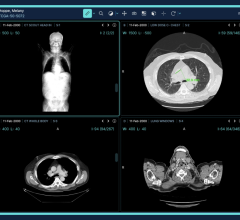Hospitals, radiology centers and radiation oncology clinics are struggling to cope with the explosion of patient data. As advances in imaging and instrumentation continue to develop and the volume of output expands ever faster, existing storage infrastructures cannot keep pace. As a result, many organizations are investigating in cloud storage as a means to better manage data growth and decrease costs.
Early-Cloud Adopters
Amazon put cloud storage on the map in 2006 with the introduction of Simple Storage Service (S3) to complement its elastic computing initiative.
Since then, there have been many alternatives introduced, including software to build private clouds within an organization’s data center and hosting services for private clouds.
Through a private cloud a radiologist can read studies, coordinate with subspecialists via teleradiology, and integrate diagnostic imaging (DICOM) across hospital and clinic networks. The same cloud can also be used to disseminate scanned documents and standard digital health records (CCR, CCD) across an extended healthcare network through secure online connections.
The sheer size and volume of documents are pushing organizations to cloud storage. For example, a typical CT scan can exceed 15 megabytes, a digital mammography study can grow to more than 200 megabytes, and an MRI study can easily exceed these figures. A cloud infrastructure replaces express shipments of a CD or the purchase and installation of a specialized gateway computer. The back-end storage platform used to store and manage medical images ultimately has an impact on the cost and quality of care.
Existing proprietary storage appliances are expensive to purchase and maintain. In an attempt to save money, administrators move images from the most current storage appliances to older, less expensive storage devices as the image ages, but management of these appliances frequently requires downtime to perform maintenance, upgrade equipment or perform large-scale migrations. Storage downtime can impact the accessibility of patient records stored on systems in need of maintenance or repair, and patient care can be affected. As a chief information officer of a major hospital recently stated, “any downtime for a clinician is too long.”
In contrast, cloud storage abstracts data from the underlying hardware. Administrators are able to move data, upgrade equipment and even completely change the hardware without imposing downtime. Another major difference of cloud storage is archiving. Tiered storage solutions that archive images often have to balance the cost advantages of archiving with the accessibility and the physicians’ need to view a patient’s prior images.
Cloud storage provides much greater flexibility in image accessibility. A cloud can consist of components with a wide variety of performance and cost characteristics. Documents and files can be moved across these different tiers without disrupting access. These tiers are transparent to users who access the cloud directly with a vast collection of images at their fingertips.
However, this is countered by distance and availability in certain locations, as image files can be quite large. Some organizations deploy hybrid solutions that combine an on-premise PACS solution component with cloud storage. The most recent images are readily accessible locally and the cloud is used for redundancy of local images and for access of a vast array of older images.
Jon Greaves, chief technology officer at Carpathia Hosting Inc. in Ashburn, Va., said, “In many cases, customers require a hybrid solution that blends a managed infrastructure with cloud capacity on demand. For example, one of our PACS customers is able to complement their on-premise solution with cloud-based storage as back up. This approach dramatically reduces costs allowing them to pay for just the storage they use. It also allows them to have a central location storing data from multiple sites opening up opportunities for collaboration, data exchange and disaster recovery.
Given the many solutions available on the market and the wide disparity in cloud solutions, it’s important to understand the best practices healthcare organizations must adopt to effectively and efficiently manage, store and archive their data. Those who value the cost, flexibility, data protection and security of their data need to understand what’s behind a service provider’s infrastructure.
“Our customers look to Carpathia to ensure services are delivered in a compliant manner, yet still balance price and performance. This requires storage to seamlessly integrate with existing applications and infrastructure; asking customers to change applications to support the cloud just simply isn’t an option. Carpathia selected a cloud storage platform, allowing us to focus on the key aspects of service delivery knowing we have a platform and partner that could scale to petabytes of storage,” said Greaves.
There are a number of factors that should be considered when comparing cloud infrastructures, including cost, performance and data protection.
Total Storage Costs
For an on-premise private storage cloud, it’s relatively straightforward to evaluate capacity and hardware costs. If you have the ability to select any standard hardware, then power and cooling costs are well understood. When evaluating a cloud storage service, it’s important to be aware of the total software storage costs, bandwidth costs, and how these change with volume.
Avoid “Hotel California” cloud storage providers. These services allow users to check in data anytime they want, but given the bandwidth charges, users can never leave.
Performance
Performance can vary depending on the type of workloads, number of studies, teleradiology activity, and the number of locations. It’s important to understand how the underlying system works. How open is the underlying storage? Does the PACS vendor use a cloud service that is cost effective and not locked into one clinical application vendor? Does it support parallel access to speed reads across users and locations? Traditional network storage solutions force all data to pass through a single storage head, preventing scalability. The leading storage cloud solution scales performance by spreading the load from clients across all the nodes within the cloud. As the cloud grows, the additional nodes are able to service the data access requests in parallel.
Data Protection
Information is an asset whether the data is in your four walls or hosted in someone else’s data center. That asset must still be protected. When evaluating cloud storage, determine how data is protected. What is the redundancy level? With traditional backup systems all data is treated equally. Does the cloud storage vendor provide multitenancy features? How flexible are data protection policies? How does it comply with HIPAA? Is there a mechanism to provide more protection or security for selected content? What happens in case of failure? How automated is the response?
In addition to solving some of the immediate cost and accessibility issues, cloud storage also provides a foundation for change. All too often, information is housed in fragmented storage silos. A cloud infrastructure enables the integration of these silos and the ability to securely share information across entities.
Hospitals, radiology centers and radiation oncology clinics no longer need to be concerned with how they will cope with the exploding data. Cloud storage provides an incremental, pay-as-you grow approach that easily expands to meet the increasing demands of healthcare services.
Through the cloud, studies can be accessed by radiologists across long distances or across the hall. Patient information can be shared across systems and integrated into sophisticated workflows streamlining processes. As physicians, administrators and IT managers work together to analyze how to improve their systems and processes, the future looks very cloudy.
Author: Jack Norris is vice president of marketing and business development for ParaScale Inc., a Silicon Valley leader in developing cloud storage software solutions.


 December 01, 2025
December 01, 2025 









